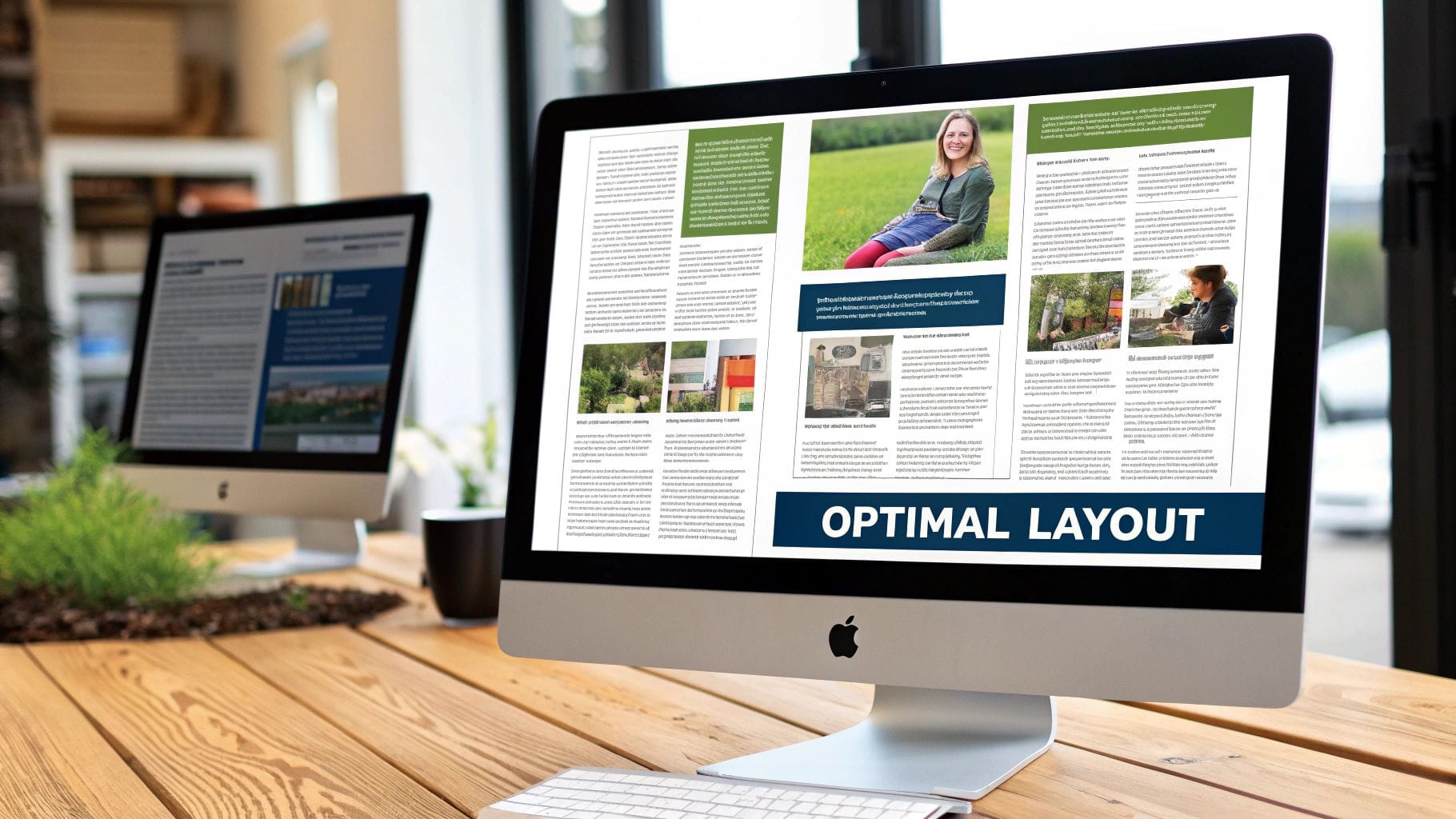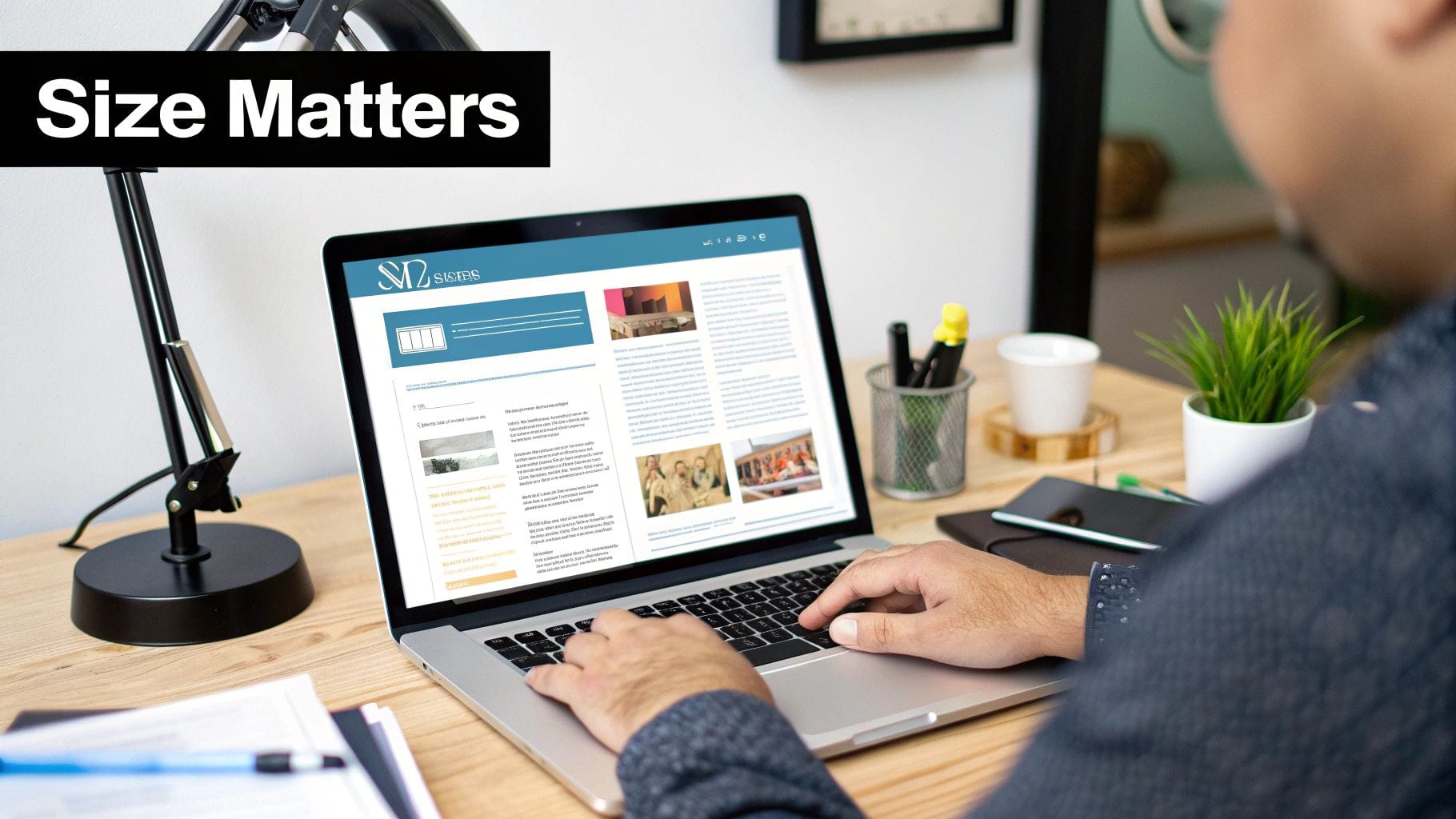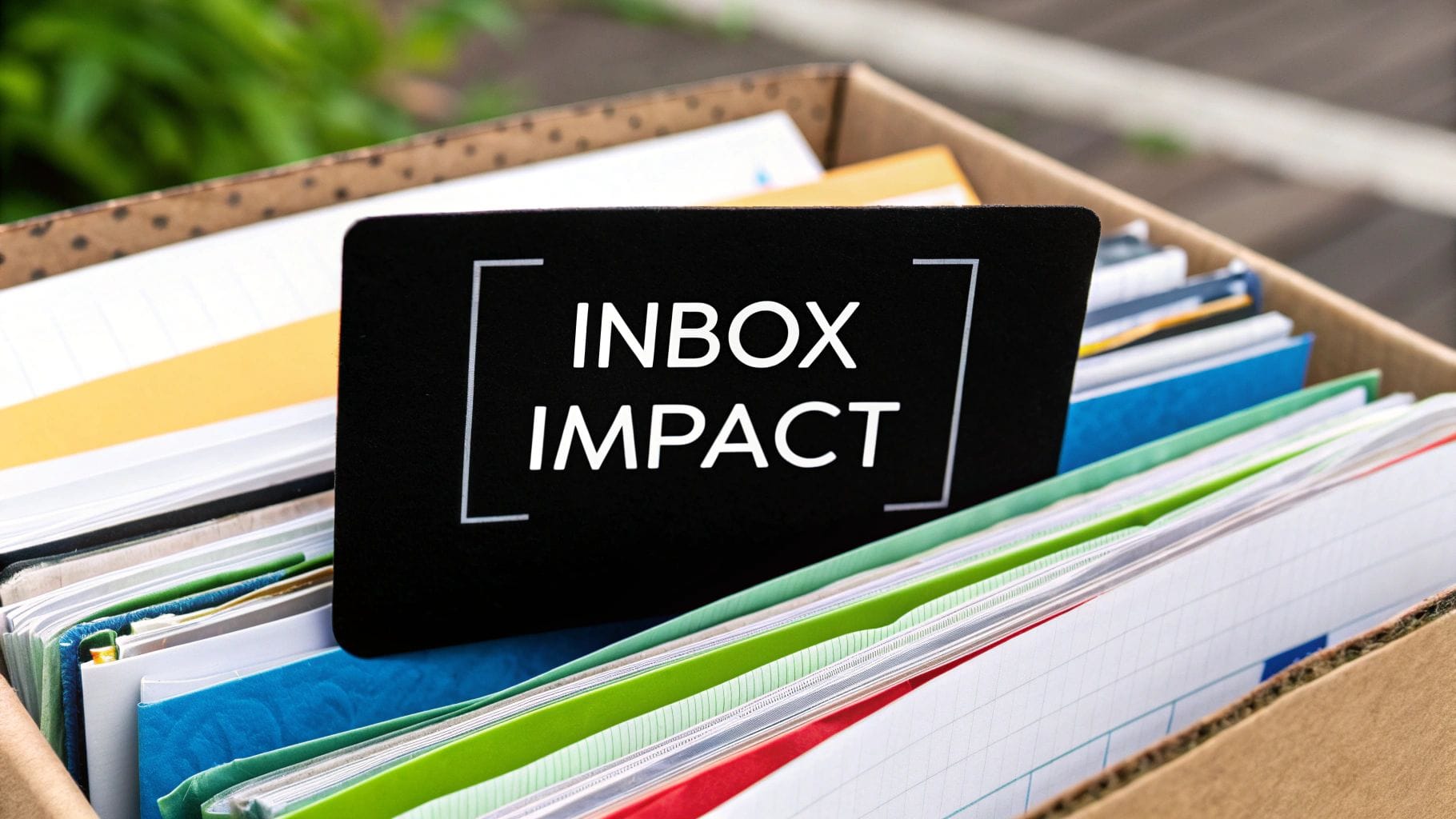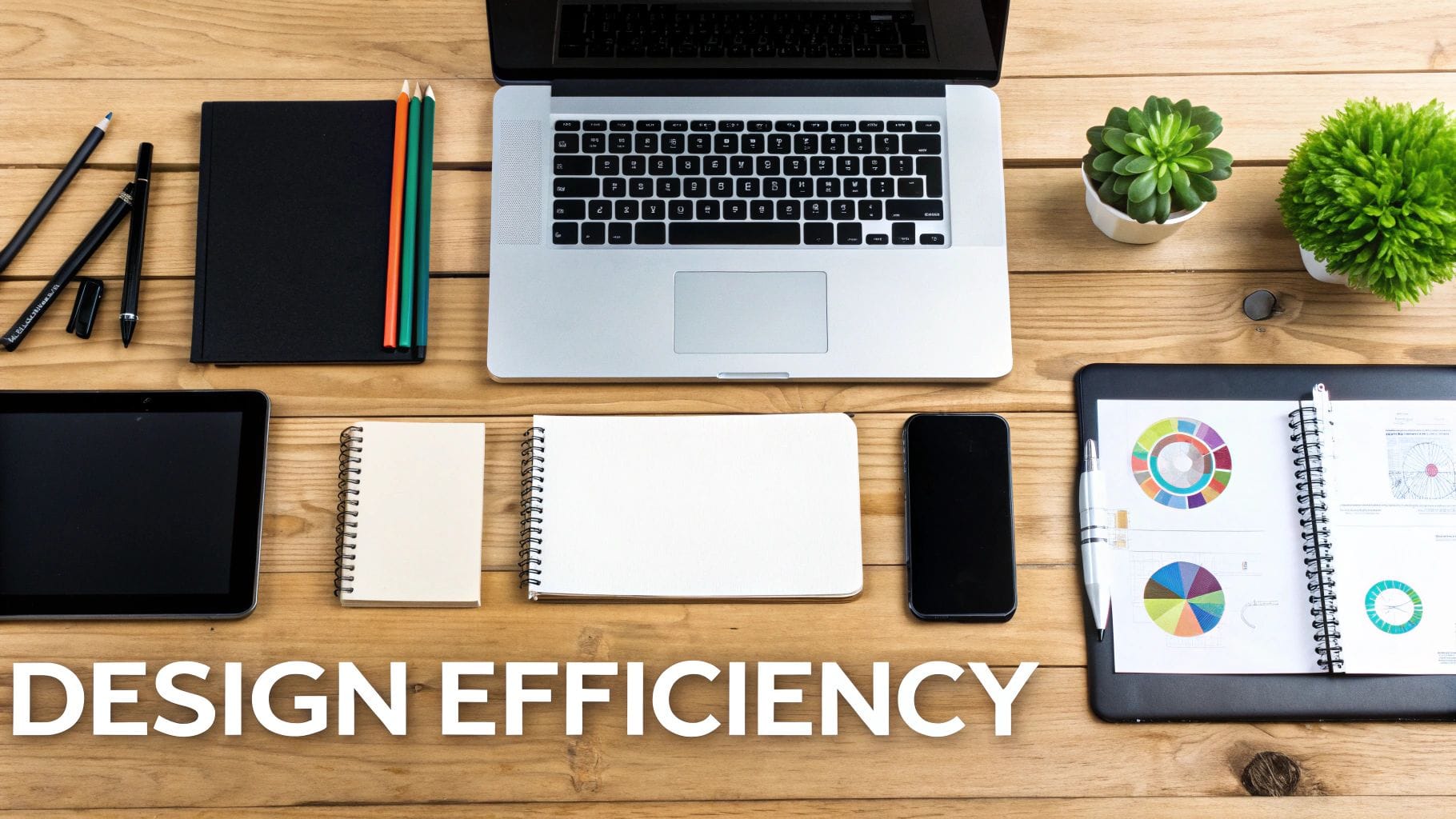The Ultimate Guide to Newsletter Length: Crafting Perfect Email Content That Drives Results
The Ultimate Guide to Newsletter Length: Crafting Perfect Email Content That Drives Results
Understanding the Science of Newsletter Length

Finding the right length for your newsletter takes more than following generic rules. It requires understanding how your readers engage with your content, analyzing real data, and considering practical factors like reading environments and content types. Let's explore the key elements that influence optimal newsletter length and how you can use them to create more engaging emails.
Debunking the 200-Word Myth
You've probably heard that 200 words is the "perfect" newsletter length. While studies by companies like Constant Contact show this length often gets good click rates due to the typical one-minute reading time, the reality is more complex. For instance, specialized newsletters covering topics like finance or technology frequently see strong engagement even at longer lengths. Think of it like reading a magazine article - when the content matters to readers, they'll gladly spend more time with it. For more insights, check out our guide on how long should an email newsletter be in 2024.
The Impact of Reading Environment and Device
Where and how people read your newsletter matters just as much as length. Someone quickly checking email on their phone during their commute has different needs than someone reading at their desk. Screen size especially affects how long a newsletter feels - 200 words might look brief on desktop but feel just right on mobile. This highlights why responsive design that works well across devices is so important.
Content is King, Context is Queen
Word count alone doesn't tell the full story. The type of content you're sharing should guide your length decisions. A quick daily news update might work best at 200 words, while a weekly deep dive could need more space to deliver value. The key is matching your newsletter length to both your content goals and what your readers expect. Focused, insightful content will hold attention regardless of length, while unfocused writing loses readers quickly.
The Power of Interactive Elements
Adding elements like videos, polls and GIFs can change how readers engage with your newsletter. While these may increase the overall size, they can significantly boost interaction and keep readers interested. According to Beehiiv's analysis of billions of emails, interactive content increases open rates, with videos driving click rates up by 300%. This shows that strategic use of multimedia can support longer newsletters while maintaining strong performance. The real skill lies in finding the right mix of text and interactive elements for your specific audience.
Balancing Frequency and Content Length
Getting the newsletter length right requires carefully balancing how often you send emails with how much content each one contains. Like choosing the right mix of text and interactive elements, finding the sweet spot between staying connected with subscribers and overwhelming them is essential. This means thinking strategically about email frequency and adjusting content length accordingly.
The Frequency-Length Connection
How often you send your newsletter directly affects how long it should be. For example, daily newsletters need to be much shorter than monthly ones. The logic is simple - readers getting daily updates want quick, digestible information they can scan quickly. Long daily emails quickly lead to reader burnout. Monthly newsletters, on the other hand, give you space to explore topics in more depth.
Daily Delights: Short and Sweet
For daily newsletters, keep things brief. Aim for under 200 words - about what readers can digest in one minute of reading time. This lets subscribers quickly grasp the key points without getting bogged down. A daily news roundup or industry update works well in this format, giving readers just what they need to stay informed.
Weekly Wisdom: Finding the Middle Ground
Weekly newsletters give you more flexibility with length. You have room to tell stories, analyze trends, or share useful resources while still respecting readers' time. Around 300-500 words tends to work well - enough space to explore a topic or share a case study with concrete takeaways.
Monthly Musings: The Long-Form Approach
Monthly newsletters allow for the most in-depth content. You can thoroughly explore complex topics, create detailed guides, or feature extensive interviews. While there's no strict word limit, make sure the length matches the value you're providing. Even with less frequent sending, keep content focused and relevant. You might want to check out: A strategic guide for maximum engagement.
Finding Your Perfect Rhythm
The ideal newsletter length depends on your specific audience, industry and content goals. Test different lengths and frequencies while tracking metrics like opens, clicks and unsubscribes. This data will help you optimize your approach. Try A/B testing different formats - like comparing shorter, more frequent newsletters to longer, less frequent ones. By continuously measuring and adjusting based on results, you'll find the format that works best for engaging your subscribers.
Mastering Engagement Through Strategic Length

Creating the right newsletter length requires balancing valuable content with reader attention spans. Rather than focusing solely on word count, success comes from thoughtful formatting and presentation that keeps readers engaged. Let's explore proven strategies for maintaining reader interest, regardless of newsletter length.
The Power of Formatting
Smart formatting makes a huge difference in how readers interact with your newsletter content. Much like an easy-to-scan webpage, breaking up text with clear headings, bullet points, and relevant visuals creates a more inviting reading experience. Using shorter paragraphs and mixing up sentence structure helps prevent reader fatigue from dense blocks of text. When done well, this approach helps longer newsletters feel approachable and encourages readers to keep scrolling.
Content Blocks: Chunking Information for Maximum Impact
Just as good formatting improves readability, organizing content into distinct sections enhances understanding and engagement. Each section should focus on one key message, creating a natural flow from topic to topic. This structure lets readers quickly scan and find what interests them most. Clear breaks between sections also give readers natural pauses to process information - especially important for longer newsletters where maintaining focus matters.
Content Block Type | Example | Benefit |
|---|---|---|
News Update | Briefly summarize key industry news. | Provides concise, valuable information. |
Feature Article | Deep dive into a specific topic. | Offers in-depth analysis and insights. |
Tip of the Week | Share a practical tip or advice. | Delivers actionable value quickly. |
Customer Spotlight | Showcase a customer success story. | Builds social proof and trust. |
Visual Elements: Enhancing Engagement and Retention
Images, GIFs and videos play a vital role in grabbing attention and improving the reading experience. Visual content breaks up text and communicates complex ideas efficiently. However, balance is key - too many visuals can slow loading and create clutter. Choose high-quality images that directly support your content and provide value. A selective approach results in a more polished and professional newsletter.
When selecting visuals, consistent branding strengthens recognition and trust. Using your brand's colors, fonts and style guidelines creates a cohesive look readers come to recognize. This visual consistency, paired with well-structured content, creates an engaging experience that keeps subscribers coming back. Even longer newsletters can become valuable relationship-building tools when crafted thoughtfully.
Leveraging Interactive Elements Effectively

Interactive elements like videos, GIFs, polls and quizzes can turn a basic newsletter into an engaging experience that captures readers' attention. However, successful implementation requires careful consideration of both placement strategy and technical constraints. The key is finding the right balance between engagement and email size optimization.
The Impact of Interactivity on Newsletter Size for Email
While interactive content makes newsletters more engaging, it also increases file size. For instance, directly embedding videos often causes compatibility issues and bloats the email. A better approach is using clickable thumbnail images that link to hosted videos - similar to how movie trailers preview full films. This keeps email size manageable while still providing rich media experiences.
Balancing Rich Media With Text Content
Finding the sweet spot between interactive elements and text is essential for an effective newsletter. Too many interactive features can overwhelm readers, while too few make the content feel flat. Shorter newsletters may only need one or two carefully chosen interactive elements, while longer ones can incorporate more. Focus on quality over quantity - a strategically placed poll often drives more engagement than multiple random GIFs.
Maintaining Loading Speeds and Email Client Compatibility
Interactive content that isn't properly optimized can slow down loading times, especially for readers with slower internet connections. Additionally, not all email clients support every type of interactive feature. Testing across different email platforms and devices is crucial for consistent delivery and a smooth user experience. You might be interested in: The importance of responsive HTML email template.
Testing and Optimizing Interactive Elements
Before rolling out interactive elements broadly, test different approaches to see what works best. Compare metrics like click rates and time spent between newsletters with different interactive features. For example, test how a video thumbnail performs versus a static image. Gather subscriber feedback through surveys to understand preferences and identify potential issues. This iterative testing helps refine your approach while keeping the newsletter engaging and user-friendly.
Customizing Length for Your Industry
The ideal newsletter length varies significantly by industry and context, much like how different professionals need different tools for their work. Each sector has distinct reader expectations and content consumption habits that shape how newsletters are best received. Success often means understanding and adapting to these specific needs rather than following generic rules.
Industry Benchmarks and Best Practices
While 200 words is often cited as a baseline length, successful newsletters frequently diverge from this guideline based on their audience and purpose. Take the fashion industry - their newsletters tend to be highly visual with minimal text, focusing on product shots and style inspiration. You can learn more in our guide to understanding best practices for a fashion newsletter. In contrast, finance and tech newsletters often require longer formats to properly explain complex topics and analysis. Just as a quick news update serves a different purpose than an in-depth market report, newsletter length should match the content's goals.
Adapting to Your Audience's Needs
Success starts with knowing your specific audience. Are you writing for busy executives who want quick takeaways, or subject matter experts seeking comprehensive analysis? Your answer shapes both length and format. Business-to-business (B2B) newsletters often need space for technical details and industry context, while business-to-consumer (B2C) versions typically benefit from being shorter and more focused. Consider how your readers access your content too - mobile readers may prefer shorter formats than desktop users.
Content Types and Their Impact on Length
Different content naturally requires different lengths for maximum impact. Daily news roundups can be brief while still providing value. Weekly deep dives need more space to explore topics thoroughly. Product announcements, promotions, and event notices each have their sweet spot - a new product might need just a few eye-catching visuals and key details, while a software tutorial requires step-by-step explanation.
Testing and Iteration for Continuous Improvement
The best way to find your optimal newsletter length is through consistent testing and measurement. Track metrics like open rates, click-throughs, and unsubscribes as you try different formats. A/B testing newsletters of varying lengths helps identify what resonates with your specific audience. This data-driven approach allows you to refine your strategy over time, ensuring your newsletters hit the mark consistently. By paying attention to the results and adjusting accordingly, you can develop a format that truly engages your readers.
Measuring and Optimizing Newsletter Performance

Getting your newsletter size right is just the starting point. The real key is understanding how that size impacts your results by looking at specific metrics that show how engaged your readers really are. This means going deeper than basic open rates to see exactly how your content connects with subscribers.
Beyond Open Rates: Metrics That Matter
While open rates show you who sees your subject line, they don't tell the full story. Click-through rates give you a clearer picture of whether your content actually grabs readers' interest. For example, if you have lots of opens but few clicks, your subject line works but the content may need improvement. Looking at time spent reading, how far people scroll, and social shares tells you even more about engagement. When readers make it to the bottom of a longer newsletter, that's a good sign they find value in your content. But if they quickly leave a shorter newsletter without scrolling much, the content might not be meeting their needs.
The Power of A/B Testing for Newsletter Size
A/B testing helps you find the ideal length for your newsletters through real data. Send two versions with different word counts to separate subscriber groups and compare the results. You could test a 200-word version against a 400-word version and see which gets more clicks. This removes the guesswork by showing exactly what resonates with your audience. Try testing things like where you place key calls-to-action within newsletters of different lengths.
Analyzing and Interpreting Performance Data
After collecting A/B test results and tracking metrics, take time to spot meaningful patterns. Look for connections between newsletter length and reader engagement. Does a certain word count consistently perform better? The data will point you toward specific ways to improve your content and optimize newsletter length. Raw numbers only become useful when you understand what they reveal about your subscribers' preferences.
Building a Testing Framework for Continuous Improvement
Optimizing your newsletter is an ongoing process that requires consistent testing and refinement. Create a system for regularly experimenting with different lengths and formats while tracking key metrics. Document what works and what doesn't. This data-driven approach helps you steadily improve results over time. Want more newsletter growth strategies? Check out: Proven ways to grow your newsletter subscribers. By continuously evaluating and adjusting based on actual results, you can keep your newsletter engaging and effective.
Ready to take your newsletter to the next level? Inagiffy is an end-to-end newsletter service that handles everything from server optimization and branding to content creation, ensuring readership and revenue growth. Visit inagiffy.news today to learn more.